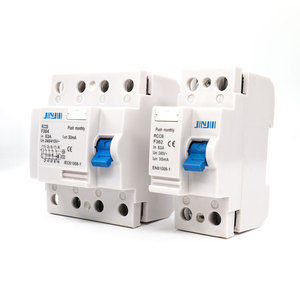Introduction to 4P RCCB
The 4P RCCB (Residual Current Circuit Breaker) is a crucial component in electrical installations, designed to protect against the risks of electric shock and electrical fires caused by current leakage. This device ensures enhanced safety by detecting imbalances between the live and neutral wires, interrupting the circuit when an imbalance is detected. Its four-pole design allows monitoring of three-phase electrical systems along with a neutral line, making it an integral choice for industrial, commercial, and residential applications.
Types of 4P RCCB
4P RCCBs come in various types to cater to different requirements and applications. Understanding these varieties can help users select the ideal model for their specific needs:
- Type AC: Designed for standard alternating current applications, suitable for most residential and commercial uses.
- Type A: Capable of detecting both AC and pulsating DC residual currents, making it suitable for circuits that may involve electronic equipment.
- Type B: This type detects sinusoidal AC and smooth DC residual currents and is essential for industrial applications that handle photovoltaic systems or EV charging points.
- Type F: Combines characteristics of both Type A and Type B RCCBs, allowing it to detect a wide range of residual currents, suitable for complex circuits including mixed loads.
Applications of 4P RCCB
The versatility and safety features of the 4P RCCB make it ideal for a wide spectrum of applications:
- Industrial Systems: Protects machinery and sensitive equipment from electrical faults, ensuring operational safety and reducing downtime.
- Commercial Buildings: Ensures safety in offices, retail outlets, and institutions with multiple electrical devices prone to faults.
- Residential Installations: Provides peace of mind in home electrical systems, protecting family and property from electrical hazards.
- Outdoor and Agricultural Uses: Ensures safe operation of electrical circuits in agriculture, greenhouses, and outdoor settings, where environmental factors may increase risk.
Function, Feature, and Design of 4P RCCB
Understanding the core functionalities and features of the 4P RCCB highlights its pivotal role in electrical safety:
- Functionality: The primary function of a 4P RCCB is to continuously monitor the electrical current flow. It automatically disconnects the circuit on detecting leakage currents that exceed the preset threshold.
- Design: Constructed with a compact form factor, the 4P RCCB typically features a modular design which allows easy integration into existing electrical panels.
- Test Button: Equipped with a test button, users can frequently check the functionality of the RCCB to ensure it operates correctly when needed.
- Durability and Reliability: Built using high-quality materials, 4P RCCBs are designed to withstand harsh environments and demanding conditions, ensuring long-term reliability.












































































































































































































